Lancia Ypsilon 2011 Owner handbook (in English)
Manufacturer: LANCIA, Model Year: 2011, Model line: Ypsilon, Model: Lancia Ypsilon 2011Pages: 299, PDF Size: 13.35 MB
Page 91 of 299
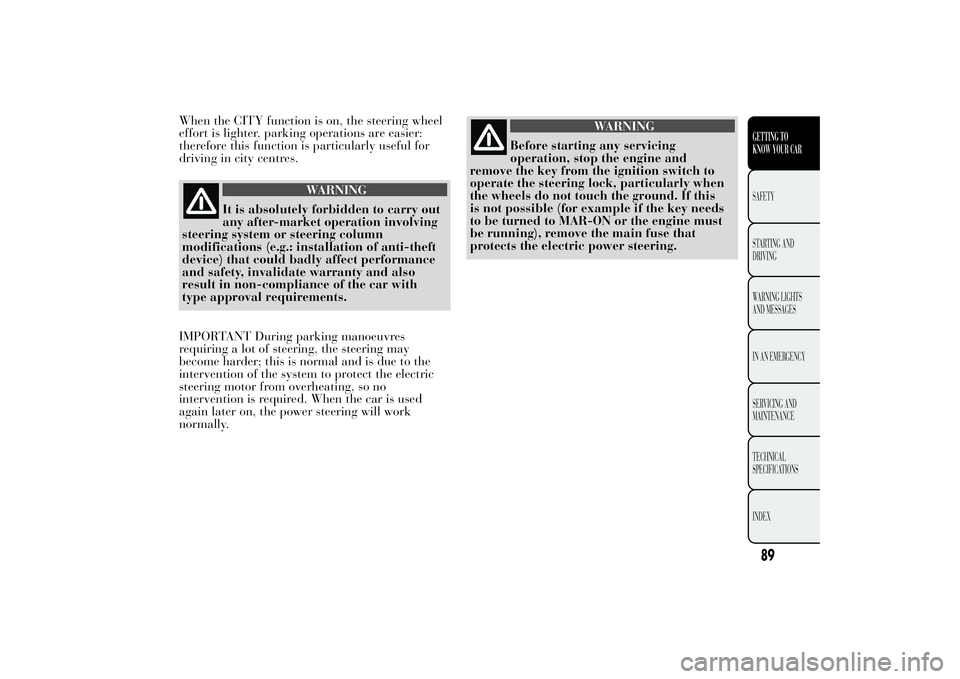
When the CITY function is on, the steering wheel
effort is lighter, parking operations are easier:
therefore this function is particularly useful for
driving in city centres.
WARNING
It is absolutely forbidden to carry out
any after-market
operation involving
steering system or steering column
modifications (e.g.: installation of anti-theft
device) that could badly affect performance
and safety, invalidate warranty and also
result in non-compliance of the car with
type approval requirements.
IMPORTANT During parking manoeuvres
requiring a lot of steering, the steering may
become harder; this is normal and is due to the
intervention of the system to protect the electric
steering motor from overheating, so no
intervention is required. When the car is used
again later on, the power steering will work
normally.
WARNING
Before starting any servicing
operation, stop the
engine and
remove the key from the ignition switch to
operate the steering lock, particularly when
the wheels do not touch the ground. If this
is not possible (for example if the key needs
to be turned to MAR-ON or the engine must
be running), remove the main fuse that
protects the electric power steering.
89GETTING TO
KNOW YOUR CARSAFETY
STARTING
AND
DRIVING
WARNING LIGHTS
AND MESSAGES
IN AN EMERGENCY
SERVICING AND
MAINTENANCE
TECHNICAL
SPECIFICATIONS
INDEX
Page 92 of 299
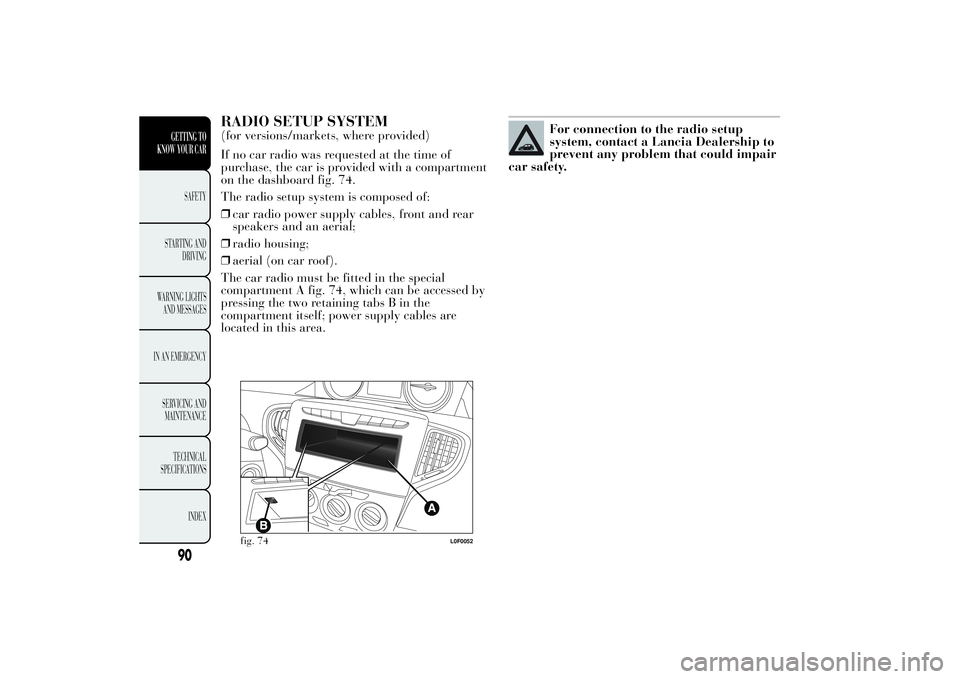
RADIO SETUP SYSTEM(for versions/markets, where provided)
If no car radio was requested at the time of
purchase, the car is provided with a compartment
on the dashboard fig. 74.
The radio setup system is composed of:
❒car radio power supply cables, front and rear
speakers and an aerial;
❒radio housing;
❒aerial (on car roof).
The car radio must be fitted in the special
compartment A fig. 74, which can be accessed by
pressing the two retaining tabs B in the
compartment itself; power supply cables are
located in this area.
For connection to the radio setup
system, contact a Lancia Dealership to
prevent any problem that could impair
car safety.
fig. 74
L0F0052
90GETTING TO
KNOW YOUR CAR
SAFETY
STARTING
AND
DRIVING
WARNING LIGHTS
AND MESSAGES
IN AN EMERGENCY
SERVICING AND
MAINTENANCE
TECHNICAL
SPECIFICATIONS
INDEX
Page 93 of 299

PREPARATION TO INSTALL A
PORTABLE NAVIGATION SYSTEMOn cars equipped with the Blue&Me
TM
system,
there may be (on request) the setup for installing
the Blue&Me
TM
TomTom
®portable navigation
system, which is available from Lineaccessori
Lancia.
Install the portable navigation system by fitting
the relevant supporting bracket in the housing
shown in fig. 75.
INSTALLING ELECTRICAL/
ELECTRONIC DEVICESINSTALLING ELECTRICAL/ELECTRONIC
DEVICES
Electrical and electronic devices installed after
buying the car in the context of after-sales service
must carry the label (see fig. 76).
Fiat S.p.A. authorises the installation of
transceivers provided that installation is carried
out at a specialised centre, in a workmanlike
fashion and in compliance with manufacturer's
specifications.
IMPORTANT Traffic police may not allow the car
on the road if devices have been installed which
modify the features of the car. This may also cause
invalidation of warranty in relation to faults
caused by the change either directly or indirectly
related to it.
FIAT S.p.A. shall not be liable for damage caused
by the installation of accessories either not
supplied or recommended by FIAT S.p.A. and/or
not installed in compliance with the provided
instructions.
fig. 75
L0F0164
fig. 76
DISPOSITIVI-ELETTRONICI
91GETTING TO
KNOW YOUR CARSAFETY
STARTING
AND
DRIVING
WARNING LIGHTS
AND MESSAGES
IN AN EMERGENCY
SERVICING AND
MAINTENANCE
TECHNICAL
SPECIFICATIONS
INDEX
Page 94 of 299
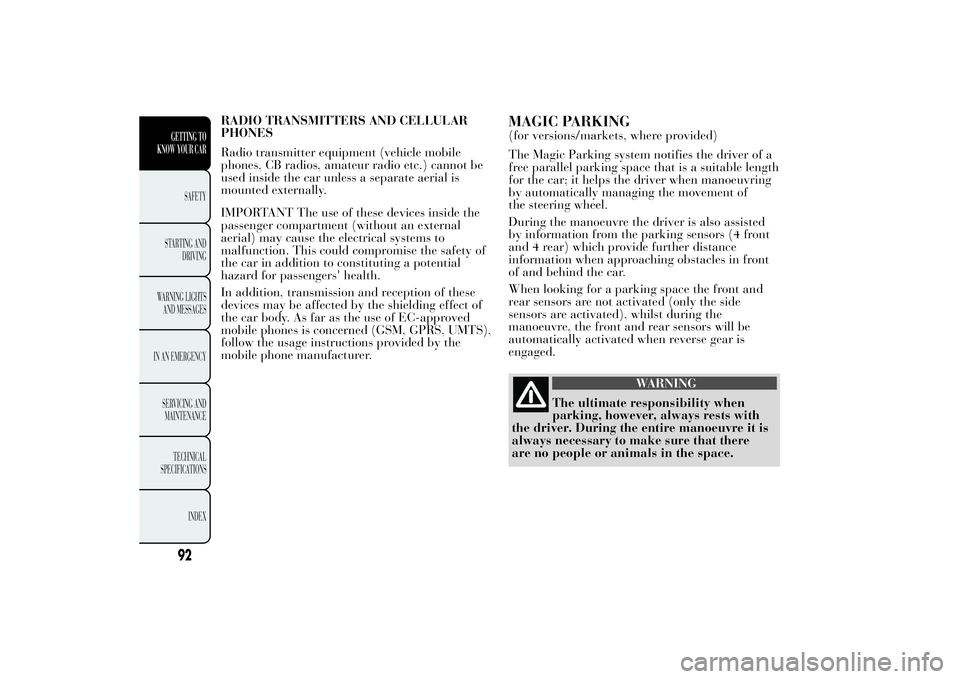
RADIO TRANSMITTERS AND CELLULAR
PHONES
Radio transmitter equipment (vehicle mobile
phones, CB radios, amateur radio etc.) cannot be
used inside the car unless a separate aerial is
mounted externally.
IMPORTANT The use of these devices inside the
passenger compartment (without an external
aerial) may cause the electrical systems to
malfunction. This could compromise the safety of
the car in addition to constituting a potential
hazard for passengers' health.
In addition, transmission and reception of these
devices may be affected by the shielding effect of
the car body. As far as the use of EC-approved
mobile phones is concerned (GSM, GPRS, UMTS),
follow the usage instructions provided by the
mobile phone manufacturer.
MAGIC PARKING(for versions/markets, where provided)
The Magic Parking system notifies the driver of a
free parallel parking space that is a suitable length
for the car; it helps the driver when manoeuvring
by automatically managing the movement of
the steering wheel.
During the manoeuvre the driver is also assisted
by information from the parking sensors (4 front
and 4 rear) which provide further distance
information when approaching obstacles in front
of and behind the car.
When looking for a parking space the front and
rear sensors are not activated (only the side
sensors are activated), whilst during the
manoeuvre, the front and rear sensors will be
automatically activated when reverse gear is
engaged.
WARNING
The ultimate responsibility when
parking, however,
always rests with
the driver. During the entire manoeuvre it is
always necessary to make sure that there
are no people or animals in the space.
92GETTING TO
KNOW YOUR CAR
SAFETY
STARTING
AND
DRIVING
WARNING LIGHTS
AND MESSAGES
IN AN EMERGENCY
SERVICING AND
MAINTENANCE
TECHNICAL
SPECIFICATIONS
INDEX
Page 95 of 299
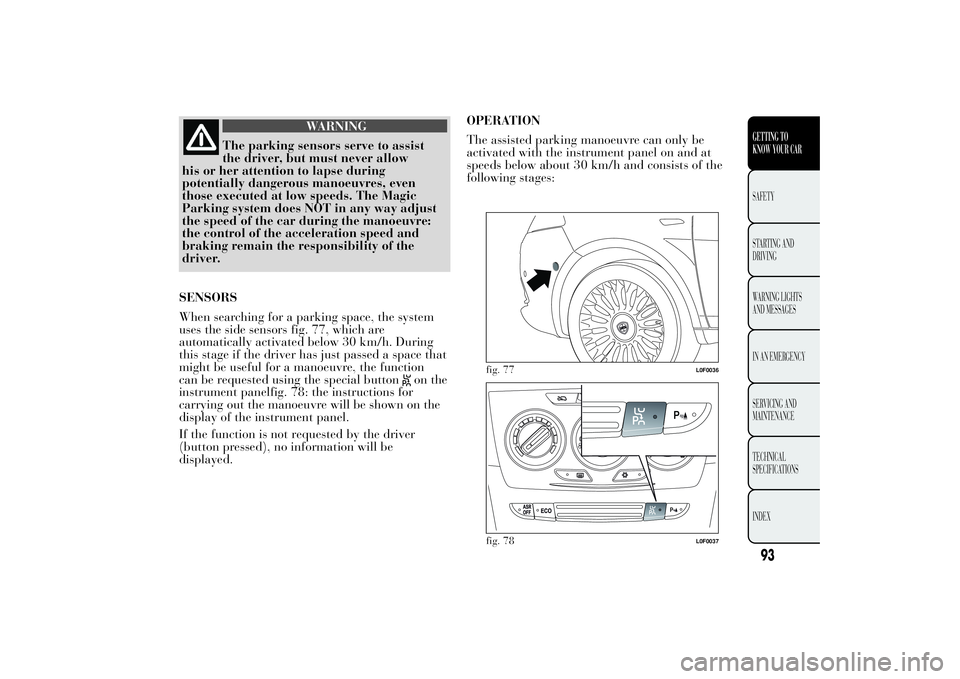
WARNING
The parking sensors serve to assist
the driver,
but must never allow
his or her attention to lapse during
potentially dangerous manoeuvres, even
those executed at low speeds. The Magic
Parking system does NOT in any way adjust
the speed of the car during the manoeuvre:
the control of the acceleration speed and
braking remain the responsibility of the
driver.
SENSORS
When searching for a parking space, the system
uses the side sensors fig. 77, which are
automatically activated below 30 km/h. During
this stage if the driver has just passed a space that
might be useful for a manoeuvre, the function
can be requested using the special button
on the
instrument panelfig. 78: the instructions for
carrying out the manoeuvre will be shown on the
display of the instrument panel.
If the function is not requested by the driver
(button pressed), no information will be
displayed.OPERATION
The assisted parking manoeuvre can only be
activated with the instrument panel on and at
speeds below about 30 km/h and consists of the
following stages:
fig. 77
L0F0036
fig. 78
L0F0037
93GETTING TO
KNOW YOUR CARSAFETY
STARTING
AND
DRIVING
WARNING LIGHTS
AND MESSAGES
IN AN EMERGENCY
SERVICING AND
MAINTENANCE
TECHNICAL
SPECIFICATIONS
INDEX
Page 96 of 299
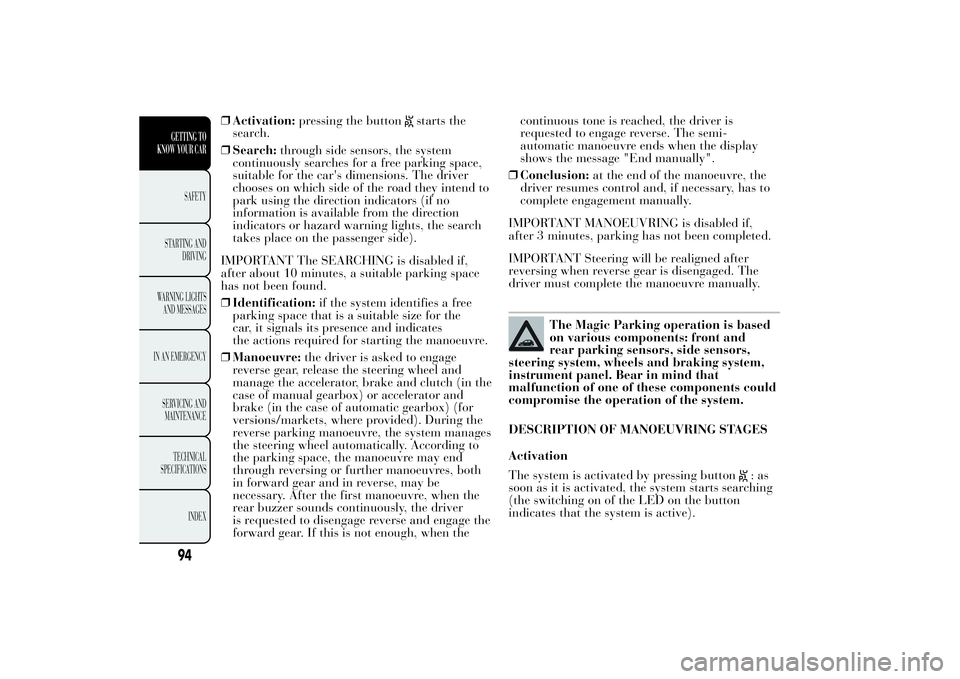
❒Activation:pressing the button
starts the
search.
❒Search:through side sensors, the system
continuously searches for a free parking space,
suitable for the car's dimensions. The driver
chooses on which side of the road they intend to
park using the direction indicators (if no
information is available from the direction
indicators or hazard warning lights, the search
takes place on the passenger side).
IMPORTANT The SEARCHING is disabled if,
after about 10 minutes, a suitable parking space
has not been found.
❒Identification:if the system identifies a free
parking space that is a suitable size for the
car, it signals its presence and indicates
the actions required for starting the manoeuvre.
❒Manoeuvre:the driver is asked to engage
reverse gear, release the steering wheel and
manage the accelerator, brake and clutch (in the
case of manual gearbox) or accelerator and
brake (in the case of automatic gearbox) (for
versions/markets, where provided). During the
reverse parking manoeuvre, the system manages
the steering wheel automatically. According to
the parking space, the manoeuvre may end
through reversing or further manoeuvres, both
in forward gear and in reverse, may be
necessary. After the first manoeuvre, when the
rear buzzer sounds continuously, the driver
is requested to disengage reverse and engage the
forward gear. If this is not enough, when thecontinuous tone is reached, the driver is
requested to engage reverse. The semi-
automatic manoeuvre ends when the display
shows the message "End manually".
❒Conclusion:at the end of the manoeuvre, the
driver resumes control and, if necessary, has to
complete engagement manually.
IMPORTANT MANOEUVRING is disabled if,
after 3 minutes, parking has not been completed.
IMPORTANT Steering will be realigned after
reversing when reverse gear is disengaged. The
driver must complete the manoeuvre manually.
The Magic Parking operation is based
on various components: front and
rear parking sensors, side sensors,
steering system, wheels and braking system,
instrument panel. Bear in mind that
malfunction of one of these components could
compromise the operation of the system.
DESCRIPTION OF MANOEUVRING STAGES
Activation
The system is activated by pressing button
:as
soon as it is activated, the system starts searching
(the switching on of the LED on the button
indicates that the system is active).
94GETTING TO
KNOW YOUR CAR
SAFETY
STARTING
AND
DRIVING
WARNING LIGHTS
AND MESSAGES
IN AN EMERGENCY
SERVICING AND
MAINTENANCE
TECHNICAL
SPECIFICATIONS
INDEX
Page 97 of 299

Since the system recognises parking spaces even
when it is deactivated, the system can be activated
straight away after having driven past an
adjacent parking space that is deemed suitable.
If the system has effectively identified a parking
space, searching will not be performed and the
system will notify the driver of the operations
required to carry out the manoeuvre correctly
through the instrument panel display .
Search for a parking space
While searching fig. 79 the car should continue
following its route at a speed of below 30 km/h
and at a distance of around 50 cm to 130 cm from
parked cars. A parking space is considered
suitable if it is about 80 cm longer than the
dimensions of the car.
Selection of search side and carrying out
manoeuvre
To select the search side and carry out the
manoeuvre, proceed as follows:1)
Choose to carry out the search for the space
and the manoeuvre on the passenger side with:
❒direction indicator in middle position;
❒hazard warning lights on;
❒hazard warning lights on and direction indicator
in passenger side position;
❒direction indicator activated in passenger side
position.
2)Choose to carry out the search for the space
and the manoeuvre on the driver's side with:
❒direction indicator activated in driver's side
position;
❒hazard warning lights on and direction indicator
in driver's side position.
The system will notify the driver of the side on
which the search and the manoeuvre will take
place by displaying messages and switching on the
or
warning lights on the instrument panel.
Searching occurs on both sides of the road:
therefore the selection can be made through the
direction indicators even after having passed
a suitable parking place.
IMPORTANT While searching, speed should not
exceed 30 km/h; when 25 km/h has been reached,
the driver is asked to decrease the speed; if the
speed of 30/h is exceeded, the system is disabled;
in this case, the system must be restarted by
pressing button
).
fig. 79
L0F1001
95GETTING TO
KNOW YOUR CARSAFETY
STARTING
AND
DRIVING
WARNING LIGHTS
AND MESSAGES
IN AN EMERGENCY
SERVICING AND
MAINTENANCE
TECHNICAL
SPECIFICATIONS
INDEX
Page 98 of 299
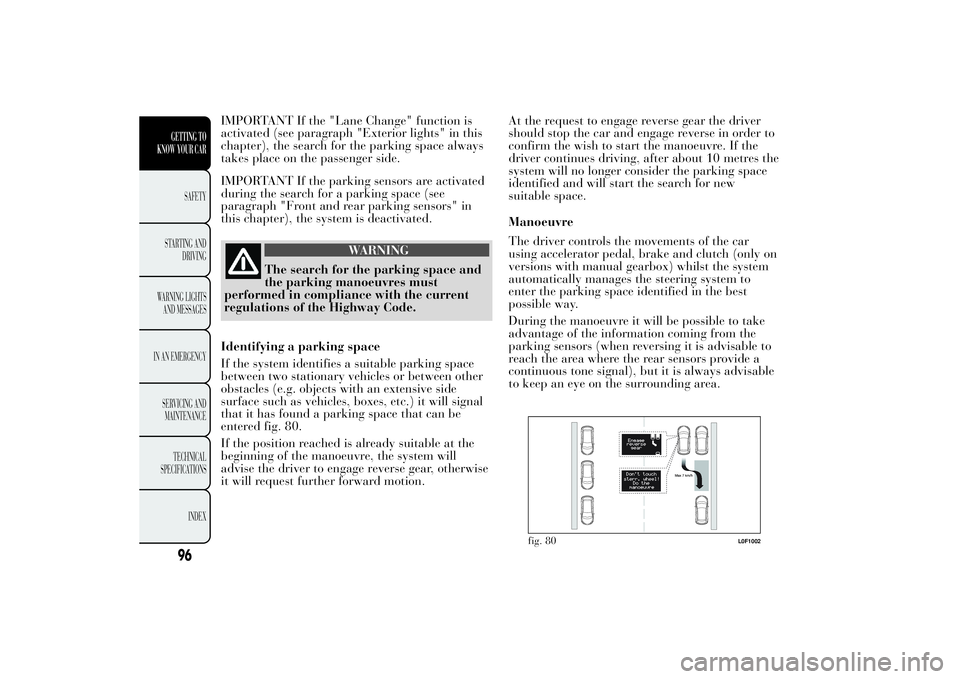
IMPORTANT If the "Lane Change" function is
activated (see paragraph "Exterior lights" in this
chapter), the search for the parking space always
takes place on the passenger side.
IMPORTANT If the parking sensors are activated
during the search for a parking space (see
paragraph "Front and rear parking sensors" in
this chapter), the system is deactivated.
WARNING
The search for the parking space and
the parking manoeuvres
must
performed in compliance with the current
regulations of the Highway Code.
Identifying a parking space
If the system identifies a suitable parking space
between two stationary vehicles or between other
obstacles (e.g. objects with an extensive side
surface such as vehicles, boxes, etc.) it will signal
that it has found a parking space that can be
entered fig. 80.
If the position reached is already suitable at the
beginning of the manoeuvre, the system will
advise the driver to engage reverse gear, otherwise
it will request further forward motion.At the request to engage reverse gear the driver
should stop the car and engage reverse in order to
confirm the wish to start the manoeuvre. If the
driver continues driving, after about 10 metres the
system will no longer consider the parking space
identified and will start the search for new
suitable space.
Manoeuvre
The driver controls the movements of the car
using accelerator pedal, brake and clutch (only on
versions with manual gearbox) whilst the system
automatically manages the steering system to
enter the parking space identified in the best
possible way.
During the manoeuvre it will be possible to take
advantage of the information coming from the
parking sensors (when reversing it is advisable to
reach the area where the rear sensors provide a
continuous tone signal), but it is always advisable
to keep an eye on the surrounding area.
fig. 80
L0F1002
96GETTING TO
KNOW YOUR CAR
SAFETY
STARTING
AND
DRIVING
WARNING LIGHTS
AND MESSAGES
IN AN EMERGENCY
SERVICING AND
MAINTENANCE
TECHNICAL
SPECIFICATIONS
INDEX
Page 99 of 299
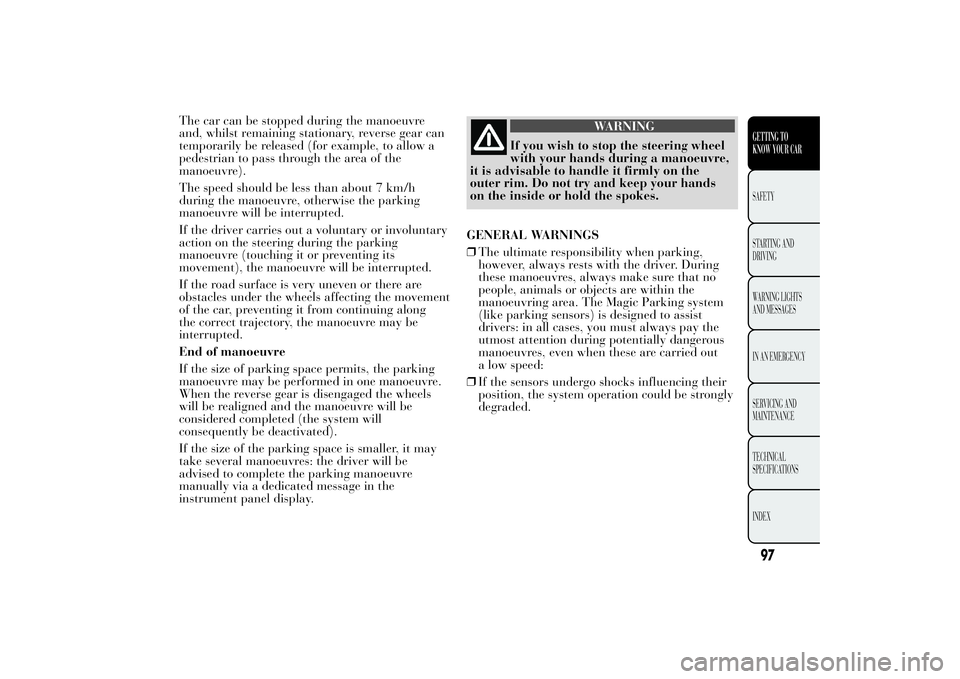
The car can be stopped during the manoeuvre
and, whilst remaining stationary, reverse gear can
temporarily be released (for example, to allow a
pedestrian to pass through the area of the
manoeuvre).
The speed should be less than about 7 km/h
during the manoeuvre, otherwise the parking
manoeuvre will be interrupted.
If the driver carries out a voluntary or involuntary
action on the steering during the parking
manoeuvre (touching it or preventing its
movement), the manoeuvre will be interrupted.
If the road surface is very uneven or there are
obstacles under the wheels affecting the movement
of the car, preventing it from continuing along
the correct trajectory, the manoeuvre may be
interrupted.
End of manoeuvre
If the size of parking space permits, the parking
manoeuvre may be performed in one manoeuvre.
When the reverse gear is disengaged the wheels
will be realigned and the manoeuvre will be
considered completed (the system will
consequently be deactivated).
If the size of the parking space is smaller, it may
take several manoeuvres: the driver will be
advised to complete the parking manoeuvre
manually via a dedicated message in the
instrument panel display.
WARNING
If you wish to stop the steering wheel
with your hands
during a manoeuvre,
it is advisable to handle it firmly on the
outer rim. Do not try and keep your hands
on the inside or hold the spokes.
GENERAL WARNINGS
❒The ultimate responsibility when parking,
however, always rests with the driver. During
these manoeuvres, always make sure that no
people, animals or objects are within the
manoeuvring area. The Magic Parking system
(like parking sensors) is designed to assist
drivers: in all cases, you must always pay the
utmost attention during potentially dangerous
manoeuvres, even when these are carried out
a low speed:
❒If the sensors undergo shocks influencing their
position, the system operation could be strongly
degraded.
97GETTING TO
KNOW YOUR CARSAFETY
STARTING
AND
DRIVING
WARNING LIGHTS
AND MESSAGES
IN AN EMERGENCY
SERVICING AND
MAINTENANCE
TECHNICAL
SPECIFICATIONS
INDEX
Page 100 of 299
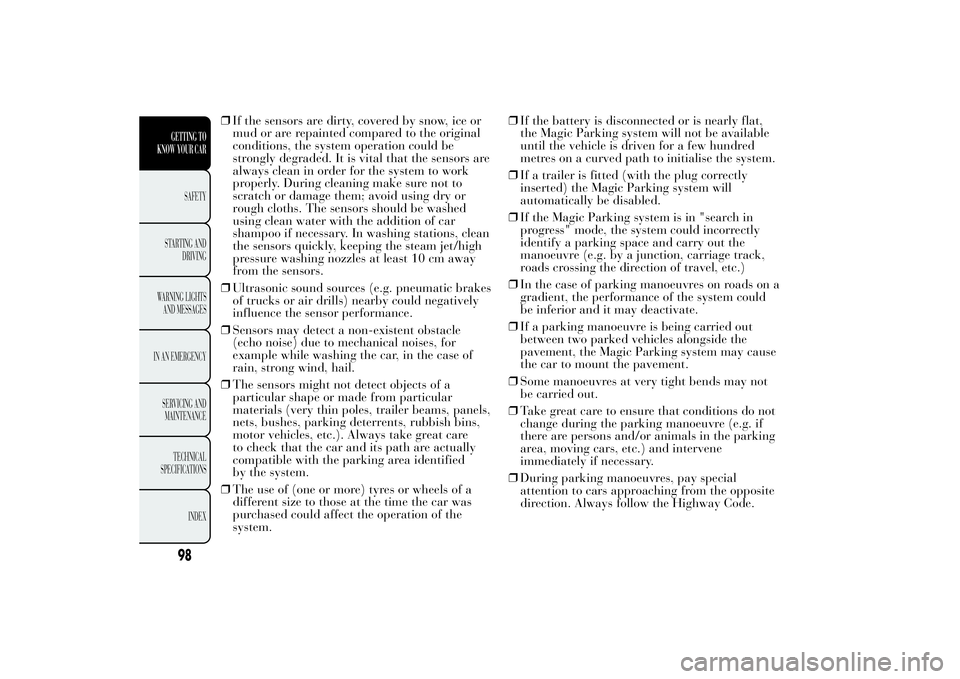
❒If the sensors are dirty, covered by snow, ice or
mud or are repainted compared to the original
conditions, the system operation could be
strongly degraded. It is vital that the sensors are
always clean in order for the system to work
properly. During cleaning make sure not to
scratch or damage them; avoid using dry or
rough cloths. The sensors should be washed
using clean water with the addition of car
shampoo if necessary. In washing stations, clean
the sensors quickly, keeping the steam jet/high
pressure washing nozzles at least 10 cm away
from the sensors.
❒Ultrasonic sound sources (e.g. pneumatic brakes
of trucks or air drills) nearby could negatively
influence the sensor performance.
❒Sensors may detect a non-existent obstacle
(echo noise) due to mechanical noises, for
example while washing the car, in the case of
rain, strong wind, hail.
❒The sensors might not detect objects of a
particular shape or made from particular
materials (very thin poles, trailer beams, panels,
nets, bushes, parking deterrents, rubbish bins,
motor vehicles, etc.). Always take great care
to check that the car and its path are actually
compatible with the parking area identified
by the system.
❒The use of (one or more) tyres or wheels of a
different size to those at the time the car was
purchased could affect the operation of the
system.❒If the battery is disconnected or is nearly flat,
the Magic Parking system will not be available
until the vehicle is driven for a few hundred
metres on a curved path to initialise the system.
❒If a trailer is fitted (with the plug correctly
inserted) the Magic Parking system will
automatically be disabled.
❒If the Magic Parking system is in "search in
progress" mode, the system could incorrectly
identify a parking space and carry out the
manoeuvre (e.g. by a junction, carriage track,
roads crossing the direction of travel, etc.)
❒In the case of parking manoeuvres on roads on a
gradient, the performance of the system could
be inferior and it may deactivate.
❒If a parking manoeuvre is being carried out
between two parked vehicles alongside the
pavement, the Magic Parking system may cause
the car to mount the pavement.
❒Some manoeuvres at very tight bends may not
be carried out.
❒Take great care to ensure that conditions do not
change during the parking manoeuvre (e.g. if
there are persons and/or animals in the parking
area, moving cars, etc.) and intervene
immediately if necessary.
❒During parking manoeuvres, pay special
attention to cars approaching from the opposite
direction. Always follow the Highway Code.
98GETTING TO
KNOW YOUR CAR
SAFETY
STARTING
AND
DRIVING
WARNING LIGHTS
AND MESSAGES
IN AN EMERGENCY
SERVICING AND
MAINTENANCE
TECHNICAL
SPECIFICATIONS
INDEX